A List of Drought Tolerant Plants
This page should give you some ideas on plants to use that are capable of surviving in low water use situations. Remember that you will also need to check that they are suitable for use in the soils that you have, as often plants will die not because of low water use but for many other reasons such as poor soils, too much or lack of exposure to sun, soil ph, pollution etc.
This list will be added to on a regular basis and if you have any ideas or suggestions please email us.
Shrubs | |
| Botanical name: Adenanthos sericeus Common name: Albany Woolly Bush Origin and habitat: Western Australia. Plant category: Shrub. Height and spread: 2.4 x 2 Habit and form: Densely foliaged shrub with hairy grey leaves and red flowers. Culture and maintenance: Treat as any member of the proteacae family. Grow in light, well drained soil with good ventilation in full sun. Provide little or no Phosphorous. Water usage: Needs very little water when established. Propagation: From seed. Environmental tolerances: Tolerates coastal conditions. Will tolerate light frosts. Horticultural usage: Useful screen shrub, bird attracting. It is also used as an Australian native Christmas tree. | |
| Botanical name: Agonis flexuosa “Nana” Common name: Dwarf willow mytrle Name derivation: It’s name comes from the Greek, “agonis”, meaning “without angles”, due to the weeping habit of the branches. Cultivars: “Nana” is a cultivar of Agonis flexuosa Origin and habitat: They come originally from the temperate regions of south-west Western Australia. Plant category: Shrub Height and spread: 1m x 1m Habit and form: Dense shrub with weeping branches Culture and maintenance: Grows in most conditions Pests and diseases: Relatively pest free, but can be troubled by spider mite. Water usage: Low Propagation: By cuttings Environmental tolerances: It is tolerant of light frosts and is very hardy Horticultural usage: Used in a wide range of sites, low maintenance and low water requirements make it a very useful plant. | |
| Botanical name: Alyogyne huegelii Common name: Native hibiscus. Name derivation: Alyogyne is from the Greek, alytos, united and gyne, woman, a reference to the undivided style. Huegelii is after Karl von Hugel, a 19th Century botanist. Cultivars: “West Coast Gem” has dark blue flowers while there are pink and white forms available. Origin and habitat: WA Plant category: Shrub. Height and spread: 2.4 x 2.5m Habit and form: Open, medium shrub. Culture and maintenance: It is fast growing and can become untidy unless pruned annually. Water usage: Drought tolerant. Propagation: From cuttings or seed. Environmental tolerances: Hardy plant, suited to most soils, provided the drainage is good. It is mildly frost tolerant. Prefers a sunny position. Horticultural usage: Very useful, quick growing shrub with attractive flowers in spring and summer. | |
| Botanical name: Aucuba japonica variegata Common name: Gold Dust Laurel Cultivars: “Crotonifolia” is strongly yellow, “salicifolia” is a female cultivar with long, narrow pointed leaves. Origin and habitat: Himalayas and Eastern Asia Plant category: Shrub Height and spread: 1.8 x 1.8m Habit and form: Rounded shrub with glossy, lanceolate leaves. Culture and maintenance: Can be pruned in spring if necessary. Will grow in full to partial shade Pests and diseases: Relatively pest free Water usage: Whilst it prefers a moist soil, it will also tolerate extremely dry periods. Propagation: Half-hardened cuttings in summer Environmental tolerances: Tolerant of atmospheric pollution, deep shade and dry soils. Horticultural usage: Avery good all rounded shrub, often used as under planting around trees. | |
| Botanical name: Buddleja davidii “Nanho Blue” Common name: Butterfly Bush. Name derivation: Named after Adam Buddle, an English botanist. Cultivars: B. “Nanho Blue” is a cultivar of B. davidii. Origin and habitat: Riversides, rocky areas of central and eastern China. Plant category: Medium deciduous shrub. Height and spread: 2.5m x 2.5m. Habit and form: Open, slightly weeping shrub. Purple/blue flowers appear in profusion during summer. Culture and maintenance: Prefers a fertile, well drained soil. Prune to old wood when flowering has finished. Water usage: Prefers dry, rather than wet soils. Will tolerate dry periods. Propagation: Semi-ripe cuttings in summer or hardwood cuttings in autumn. Environmental tolerances: Tolerant of limey soils and salt. Horticultural usage: Not only are the flowers very attractive, they are magnets to butterflies. They also flower in mid summer when not a lot else is flowering. | |
| Botanical name: Buddleja davidii “Summer Beauty” Common name: Butterfly Bush. Name derivation: Named after Adam Buddle, an English botanist. Cultivars: B. “Summer Beauty” is a cultivar of B. davidii. Origin and habitat: Riversides, rocky areas of central and eastern China. Plant category: Medium deciduous shrub. Height and spread: 2.5m x 2.5m. Habit and form: Open, slightly weeping shrub with grey leaves. Pink flowers appear in profusion during summer. Culture and maintenance: Prefers a fertile, well drained soil. Prune to old wood when flowering has finished. Water usage: Prefers dry, rather than wet soils. Will tolerate dry periods. Propagation: Semi-ripe cuttings in summer or hardwood cuttings in autumn. Environmental tolerances: Tolerant of limey soils and salt. Horticultural usage: Not only are the flowers very attractive, they are magnets to butterflies. They also flower in mid summer when not a lot else is flowering. | |
| Botanical name: Buddleja davidii “Santana” Common name: Butterfly Bush. Name derivation: Named after Adam Buddle, an English botanist. Cultivars: This is a cultivar of B.davidii. Origin and habitat: Riversides, rocky areas of central and eastern China. Plant category: Medium deciduous shrub. Height and spread: 2.5m x 2.5m. Habit and form: Open, slightly weeping shrub. Indigo/purple flowers appear in profusion during summer. Foliage is variegated with a bright gold edge. Culture and maintenance: Prefers a fertile, well drained soil. Prune to old wood when flowering has finished. Water usage: Prefers dry, rather than wet soils. Will tolerate dry periods. Propagation: Semi-ripe cuttings in summer or hardwood cuttings in autumn. Environmental tolerances: Tolerant of limey soils and salt. Horticultural usage: Not only are the flowers very attractive, they are magnets to butterflies. They also flower in mid summer when not a lot else is flowering. The variegated foliage is very eye catching. | |
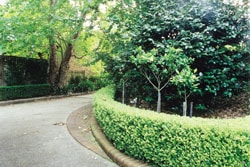 | Botanical name: Buxus sempervirens Common name: English Box Cultivars: There are many cultivars, including: “Argentovariegata” is a variegated form, “Elegantissima” will reach 1.5 m while “Suffruiticosa” can stay as little as 150mm. Origin and habitat: Europe, Western Asia and North West Africa, Open woodland and dry, rocky scrub. Plant category: Shrub Height and spread: Can grow to 9 m but the height varies with each cultivar. Habit and form: Small dense shrub. Culture and maintenance: Grows in most well drained soils, including chalk. Will need pruning in order to create a dense hedge. Pests and diseases: Relatively pest and disease free, can suffer from scale attack. Water usage: Will tolerate very dry soils. Propagation: Will propagate from cuttings and seed. Environmental tolerances: Dry shade, will tolerate most soils if they are well drained. Horticultural usage: Hedging and topiary. |
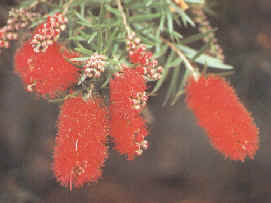 | Botanical name: Callistemon “Captain Cook” Common name: Bottlebrush Name derivation: Originates from the Greek, meaning “Beautiful stamen”. “Captain Cook” was widely promoted to commemorate the 200th anniversary of Captain James Cook’s discovery of the east coast of Australian in 1770. Cultivars: “Captain Cook” is a cultivar of C. viminalis. Origin and habitat: Australian native Plant category: Small shrub Height and spread: 1m x 1m Habit and form: Compact, bushy shrub Culture and maintenance: Hardy in most soils. Feed with a native fertilizer in spring and autumn. Pests and diseases: Prone to webbing caterpillar attacks. Water usage: Tolerant of dry soils. Propagation: Tip cuttings Environmental tolerances: Very hardy plant in most conditions Horticultural usage: Useful small, rounded shrub that requires little maintenance. |
| Botanical name: Callistemon citrinus endeavour Common name: Bottlebrush Name derivation: Originates from the Greek, meaning “Beautiful stamen”, also known as “Splendens”. “Endeavour” was coined in 1970 for the Cook bicentenary. Origin and habitat: Australian native Plant category: Medium shrub Height and spread: 2.5 x 2.5m. Habit and form: Vigorous shrub with red flower spikes up to 12 cm long. Culture and maintenance: Hardy in most soils. Feed with a native fertilizer in spring and autumn. Prune after flowering to promote bushiness and more flowering. Pests and diseases: Can be prone to Physillids. Water usage: Tolerant of dry soils. Propagation: Tip cuttings Environmental tolerances: Very hardy plant in most conditions Horticultural usage: Good screen or feature plant. This is one of the best Callistemons. | |
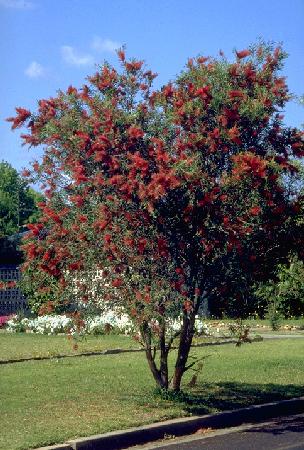 | Botanical name: Callistemon “Dawson River Weeper” Common name: Bottlebrush Name derivation: Originates from the Greek, meaning “Beautiful stamen” Cultivars: This cultivar is probably a form of Callistemon viminalis. Origin and habitat: It was originally collected in the Dawson River area of central Queensland by George Trapnell, now of Caloundra, Queensland. Plant category: Tall shrub Height and spread: 5 x 5m. Habit and form: Vigorous shrub that can be grown into a small tree. The red, bottlebrush flowers are about 90mm long by 50mm diameter and small leaves are often seen within the flower spike. Main flowering periods are spring and autumn but some flowers are found at most seasons in mild climates. Culture and maintenance: It grows best in mild to warm climates but will withstand moderate frosts without damage. Ample moisture is required to keep it in peak condition as prolonged dry periods may cause some defoliation.. As the shrub sets copious amounts of seed, pruning in early summer followed by an application of a general fertiliser will improve its vigour. Hardy in most soils. Feed with a native fertilizer in spring and autumn. Prune after flowering to promote bushiness and more flowering. Pests and diseases: Can be prone to Physillids. Water usage: Tolerant of dry soils. Propagation: Tip cuttings Environmental tolerances: Very hardy plant in most conditions Horticultural usage: Good screen or feature plant. Birds, particularly the scarlet honeyeater, are attracted to the flowers. |
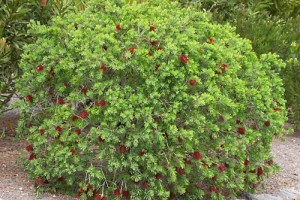 | Botanical name: Callistemon “Little John” Common name: Bottlebrush Name derivation: Originates from the Greek, meaning “Beautiful stamen” Origin and habitat: Australian native Plant category: Small shrub Height and spread: 1m x 1m Habit and form: Compact, bushy shrub Culture and maintenance: Hardy in most soils. Feed with a native fertilizer in spring and autumn. Pests and diseases: Prone to webbing caterpillar attacks. Water usage: Tolerant of dry soils. Propagation: Tip cuttings Environmental tolerances: Very hardy plant in most conditions Horticultural usage: Useful small, rounded shrub that requires little maintenance. |
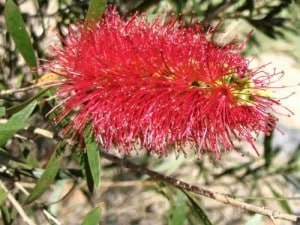 | Botanical name: Callistemon “Kings Park Special” Common name: Bottlebrush Name derivation: Originates from the Greek, meaning “Beautiful stamen” Cultivars: “Kings Park Special” was a seedling that was raised at Kings Park Botanic gardens in Perth. The origin of the seed is not known. Origin and habitat: WA. Plant category: Large shrub, small tree. Height and spread: 3 – 5m tall and 3 – 4m wide Habit and form: Dense bushy tree. Culture and maintenance: Hardy in most soils. Feed with a native fertilizer in spring and autumn. Responds well to hard pruning. Pests and diseases: Prone to webbing caterpillar attacks. Water usage: Tolerant of dry soils. Propagation: The cultivar sets viable seed but should be propagated by cuttings in order to retain form. Environmental tolerances: Very hardy plant in most conditions Horticultural usage: Very useful landscape plant. Can be pruned to a hedge or makes a good informal screen. Can be pruned into an attractive small specimen tree. |
| Botanical name: Ceanothus “Blue Pacific” Common name: Blue Pacific. Name derivation: Ancient Greek name. Cultivars: “Blue pacific” is a cultivar, probably deriving form a cross between C. americanus and C.coeruleus. Origin and habitat: Hybrid raised in Australia. Plant category: Evergreen shrub. Height and spread: 2.5 x 2.5 Habit and form: Rounded, evergreen shrub with glossy foliage. Masses of blue flowers in spring. Culture and maintenance: Prune lightly after flowering to maintain dense growth. Do not cut back into old wood. Water usage: Tolerates dry periods once established. Propagation: Soft tip or half hardened cuttings in summer. Environmental tolerances: Prefers shelter from wind and well drained soils. Resents disturbance to its roots. Horticultural usage: Very useful landscape shrub. Good screen plant. | |
| Botanical name: Choisya Ternata Common name: Mexican Orange Blossom. Cultivars: “Sundance” has pale gold foliage. Origin and habitat: Southwest USA and Mexico. Plant category: Evergreen shrub. Height and spread: 1.8 x 1.8m Habit and form: Rounded, evergreen shrub with glossy foliage. Scented white flowers in spring. Culture and maintenance: Prune lightly after flowering to maintain dense growth. Pests and diseases: Can be affected by scale. Water usage: Tolerates dry periods once established. Propagation: Half hardened cuttings rooted in summer. Environmental tolerances: Prefers shelter from wind and well drained soils. Horticultural usage: Very useful landscape shrub. Good screen plant, foliage acts as a good backdrop for other flowers. | |
| Botanical name: Cistus ladanifer Common name: Ladanum. Name derivation: cistus: Greek name for evergreen shrub. Cultivars: “C. L. Blanche” has dark green glossy leaves, grayish on the underside, “Paladin” has white flowers with dark red basal patches, “Pat” has large white flowers with maroon basal patches. Origin and habitat: North west Mediterranean and North Africa. Plant category: Rounded shrub. Height and spread: 1.5m x 1.2m. Habit and form: Dense, rounded shrub with dark green leaves that exude ladanum, and white flowers. Culture and maintenance: Prefers a well drained sandy soil in full sun. Tip prune young plants and lightly prune after flowering. Water usage: Tolerant of very dry conditions. Propagation: Cuttings. Environmental tolerances: Tolerates poor soils and thrives in a Mediterranean climate. It is rarely successful in humid conditions. Horticultural usage: Very useful shrub for harsh conditions. The prolific flowers make it a popular shrub. | |
| Botanical name: Cistus “Greyswood Pink” Common name: Rock Rose Name derivation: cistus: Greek name for evergreen shrub. Cultivars: “Greyswood Pink” is a cultivar. Origin and habitat: This cultivar can not be readily assigned. Plant category: Rounded shrub. Height and spread: 1.2m x 1.2m. Habit and form: Dense, rounded shrub with pink flowers that are paler at the petal bases. Culture and maintenance: Prefers a well drained sandy soil in full sun. Tip prune young plants and lightly prune after flowering. Water usage: Tolerant of very dry conditions. This is one of the hardiest of the Rock Roses. Propagation: Cuttings. Environmental tolerances: Tolerates poor soils and thrives in a Mediterranean climate. It is rarely successful in humid conditions. Horticultural usage: Very useful shrub for harsh conditions. The prolific flowers make it a popular shrub | |
| Botanical name: Cistus purpureus Common name: Rock Rose Name derivation: cistus: Greek name for evergreen shrub; purpurea: purple, the flowers. Cultivars: “Brilliancy” has deep pink flowers with red-brown basal spots whilst “Betty Taudevin” has dark pink flowers with maroon basal spots. “Doris Hibberson” has a profusion of pink flowers. Origin and habitat: This shrub was developed before 1790, and is a result of hybridizing between C. ladanifer and C. creticus. Plant category: Rounded shrub. Height and spread: 1.2m x 1.2m. Habit and form: Dense, rounded shrub. Culture and maintenance: Prefers a well drained sandy soil in full sun. Tip prune young plants and lightly prune after flowering. Water usage: Tolerant of very dry conditions. Propagation: Cuttings. Environmental tolerances: Tolerates poor soils and thrives in a Mediterranean climate. It is rarely successful in humid conditions. Horticultural usage: Very useful shrub for harsh conditions. The prolific flowers make it a popular shrub. | |
| Botanical name: Correa alba Common name: Correa Origin and habitat: NSW, Vic, Tas, SA. Plant category: Shrub. Height and spread: 1.5 x 1m. Habit and form: Rounded shrub. Culture and maintenance: Prefers a well drained, sandy soil in full sun or semi-shade. Light pruning will maintain compact growth. Water usage: Drought tolerant. Propagation: From cuttings. Environmental tolerances: Very tolerant of salt spray. Horticultural usage: Good front line coastal plant. | |
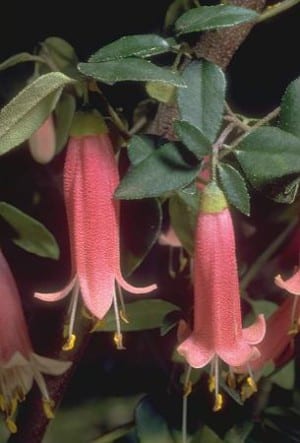 | Botanical name: Correa “Dusky Bells” Common name: Native Fuschia. Name Derivation: Correa…after Correa de Serra, a Portuguese botanist. Cultivars: Correa ‘Dusky Bells’ is believed to be a hybrid of Correa reflexa and C.pulchella. Origin and habitat: Australian native Plant category: Small shrub Height and spread: 1m x 1m Habit and form: Compact, bushy shrub. The carmine-pink flowers are bell-shaped and about 25-35 mm long. The bells are comprised of 4 petals fused together into a tube. Flowering occurs in winter and spring Culture and maintenance: Hardy in most soils. It will tolerate full sun but prefers some shade. Feed with a native fertilizer in spring and autumn. Pests and diseases: Very hardy. Water usage: Tolerant of dry soils. Propagation: Tip cuttings Environmental tolerances: Very hardy plant in most conditions, tolerates coastal conditions and light frosts. Horticultural usage: Useful small, rounded shrub that requires little maintenance. |
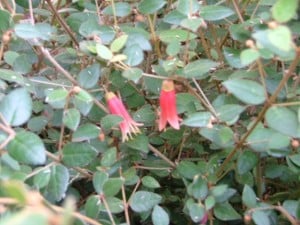 | Botanical name: Correa reflexa “Firebird” Common name: Native Fuschia. Cultivars: “Firebird is a cultivar of C. reflexa. Origin and habitat: Australian native Plant category: Small shrub Height and spread: 1m x 1m Habit and form: Compact, bushy shrub Culture and maintenance: Hardy in most soils. Feed with a native fertilizer in spring and autumn. Pests and diseases: Very hardy. Water usage: Tolerant of dry soils. Propagation: Tip cuttings Environmental tolerances: Very hardy plant in most conditions, tolerates coastal conditions. Horticultural usage: Useful small, rounded shrub that requires little maintenance. |
| Botanical name: Cupressus lusitanica “Private Green” Common name: Mexican Cypress. Cultivars: “Private Green is a cultivar of C. lusitanica. “Brices Weeping” has attractive weeping branches. Origin and habitat: Western Mexico. Plant category: Small tree. Height and spread: 12m x 5m. Habit and form: Dense conifer with slightly weeping branches. Culture and maintenance: Grow in a fertile, well drained soil, preferably in full sun. Prune to maintain shape. Pests and diseases: Can suffer fungal attack. Water usage: Once established, it requires very little water. Propagation: From cuttings in late summer. Environmental tolerances: Tolerates strong winds. Horticultural usage: This cultivar makes a dense, dark green hedge that responds well from pruning. | |
| Botanical name: Cotinus coggygria “Royal Purple” Common name: Smoke Bush. Name derivation: Cotinus is the ancient Greek name of a tree with red wood. Cultivars: “Royal Purple” is a cultivar of C. coggygria. Origin and habitat: Europe to central China. Plant category: Shrub, small tree. Height and spread: 5 x 5m. Habit and form: Open deciduous shrub. Culture and maintenance: Grows in a wide range of soils, but grow best in a well drained soil in full sun. Prune back straggly growth to promote bushiness. Water usage: Will need some water during dry periods. Propagation: Hardwood cuttings. Environmental tolerances: Adaptable to a wide range of conditions. Horticultural usage: Very useful foliage plant. The flowers provide a smoky effect. | |
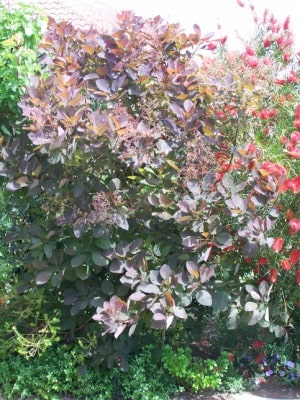 | Botanical name: Cotinus “Grace” Propagation: Hardwood cuttings. Environmental tolerances: Adaptable to a wide range of conditions. Horticultural usage: Very useful foliage plant. The flowers provide a smoky effect.Common name: Smoke Bush. Cultivars: Grace is a cultivar between Cotinus coggygria “Velvet Cloak” and Cotinus obovatus Origin and habitat: Developed at Hilliers Nursery in England. Plant category: Shrub, small tree. Height and spread: 6m x 5m. Habit and form: Open deciduous shrub. Culture and maintenance: Grows in a wide range of soils, but grow best in a well drained soil in full sun. Prune back straggly growth to promote bushiness. Pests and diseases: Water usage: Drought tolerant once established |
| Botanical name: Dodonaea viscosa purpurea Common name: Purple Hop bush. Origin and habitat: Australia and New Zealand. Plant category: Shrub. Height and spread: 5m x 1.5m Habit and form: Erect, bushy shrub. Culture and maintenance: Prefers a well drained soil in sun or part shade. Pests and diseases: Can be prone to scale. Water usage: Can tolerate extended dry periods. Propagation: By cuttings. Environmental tolerances: Tolerates most conditions. Horticultural usage: Useful screen plant. The purple foliage acts as a useful contrast. | |
| Botanical name: Echium candicans. Common name: Pride of Madeira. Origin and habitat: Micronesia, Madeira. Plant category: Soft wooded shrub. Height and spread: Can grow to 2.2m x 2.2m, but its height is variable. Habit and form: Open, slightly spreading shrub with masses of blue flowers in a spiky panicle, appearing in spring. Culture and maintenance: Feed sparingly and water little. Remove plants when they become woody. Water usage: Very low water use requirements. Propagation: Seed or cuttings. Environmental tolerances: Tolerant of coastal exposure and lime. Only mildly tolerant of frosts. Horticultural usage: Useful accent plant. Not only are the flowers eye catching, the rosette arrangement of the leaves makes them interesting all year. | |
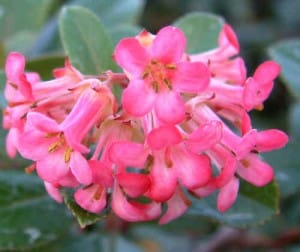 | Botanical name: Escallonia rubra. Common name: Escallonia. Name derivation: Named for Escallon, a Spanish traveler in South America. Origin and habitat: Chile Plant category: A dense bushy evergreen shrub. Height and spread: Height up to 4 – 5m width 3 – 4m.. Habit and form: It has shiny dark green foliage that is aromatic and loose panicles of red flowers. Culture and maintenance: Any soil prefers full sun. Cut back all flowering growths by half their length after flowering, older bushes can be pruned severely for shape and flowering. In aged plants remove old woody growths at ground level. Pests and diseases: Fairly pest and disease free. Water usage: Low water use.. Propagation: Soft tip cuttings in Spring or semi – hardwood cuttings taken in Autumn. Environmental tolerances: For exposed coastal areas, generally lime tolerant and drought resistant. Horticultural usage: Makes an excellent screen or hedge plant. |
| Botanical name: Grevillea “Superb” Common name: Grevillea. This is a very drought tolerant plant once established.Name derivation: Grevillea…after Charles Francis Greville, co-founder of the Royal Horticultural Society Cultivars: Grevillea “superb” is a cross between the Queensland species G.banksii and the Western Australian species G.bipinnatifida. Others with these same parents include G.”Robyn Gordon” (probably the best known and most popular of all Grevillea cultivars), G.”Ned Kelly” and G.”Coconut Ice”. All are bushy, medium shrubs with large racemes of reddish flowers. Origin and habitat: G. “Superb” differs from the other similar hybrids in that it was a deliberate cross rather than a chance seedling. The cross was carried out by well known Australian plant enthusiast and Grevillea grower, Merv Hodge. Unlike the other similar hybrids, G.”Superb” used the white form of G.banksii rather than the more common red form. Plant category: Shrub. Height and spread: 1.5m x 2m Habit and form: Vigorous shrub with large apricot-orange racemes of flowers throughout the year. The foliage is bright green and heavily divided. Culture and maintenance: Pruning is usually not required but the plant can tolerate heavy pruning if necessary. A sunny, well drained position is preferable in the garden and plants are tolerant of at least moderate frost. Fertilizers containing phosphorus are best avoided. Water usage: Tolerant of dry soils. Propagation: By cuttings. Environmental tolerances: Tolerant of moderate frosts, dislikes limeysoils. Horticultural usage: The plant is covered with flowers for most of the year and the flowers attract honeyeating birds. | |
| Botanical name: Leptospermum juniperum horizontalis. Common name: Dwarf Tea tree Name derivation: Leptospermum – from Greek leptos, slender, and sperma, seed, referring to narrow seeds of some species. Origin and habitat: Vic, Tas, NSW, SA. Plant category: Shrub. Height and spread: 1m tall and 1-2m wide. Habit and form: Open shrub with attractive white flowers in early summer. Culture and maintenance: Prune and fertilize after flowering to promote fresh new growth. This growth will provide flowers the following year. Water usage: Drought tolerant. Propagation: From cuttings or seed. Environmental tolerances: Tolerates wet and dry conditions. Horticultural usage: Useful shrub masses of white flowers in spring. A good groundcover that is very effective in mass plantings. | |
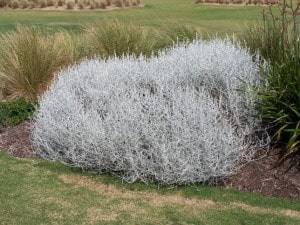 | Botanical name: Leucophyta brownii Common name: Cushion bush. Name derivation: The genus name comes from the Greek for ‘beautiful head’, referring to the flower. Origin and habitat: Vic, SA, WA. Plant category: Small shrub. Height and spread: 1m x 1m. Habit and form: Compact, rounded, silver grey shrub. It produces greenish yellow flower heads about 1cm in diameter. Culture and maintenance: Grows in most soils in full sun. Regular pruning keeps this plant compact. Water usage: Requires low water use. Propagation: From cuttings. Environmental tolerances: Tolerant of extreme dryness and coastal exposure Horticultural usage: The grey foliage creates useful contrast in the garden. |
Herbaceous plants and Perennials
| |
| Botanical name: Anigozanthos “Big Red” Common name: Tall Kangaroo Paw Name derivation: Anigozanthos; uncertain origin but probably from Greek anisos, unequal and anthos, anthers, referring to the flower shape. Cultivars: This is a cultivar of A. flavidus. Origin and habitat: W.A. Plant category: Evergreen Perennial. Height and spread: The leaves can grow to 0.5m whilst the flowers can reach 2m. It can spread to 2m wide. Habit and form: Clumping plant with strap-like leaves. The flowers are bright red. Culture and maintenance: The plant is adaptable to a variety of garden soils, including poorly drained areas. For best flowering it should be located in a sunny position and be well watered. Annual fertilizing after flowering using a general purpose fertilizer may be beneficial. Pests and diseases: Ink spot and snails can be a problem. Water usage: Prefers regular watering, but will tolerate extended dry periods. Propagation: By division or by tissue culture. | |
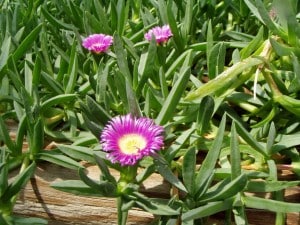 | Botanical name: Carpobrotus rossii Common name: Pig Face Origin and habitat: Coastal areas of Australia. Plant category: Succulent ground cover. Height and spread: Suckering, so will spread readily, individual plants will grow to 1m wide. Habit and form: Low, ground cover shrub. Culture and maintenance: Prefers a well drained sandy soil in full sun. Water usage: Tolerant of very dry conditions. Propagation: Cuttings. Environmental tolerances: Tolerates extreme coastal exposure. Horticultural usage: Very useful groundcover. Can be used in sand dune stabilization. |
| Botanical name: Clivea Miniata Common name: Kaffir Lilly Name derivation: Name: Clivia gained their current name from the English botanist John Lindley in 1854. Lindley (179 Name: Clivia gained their current name from the English botanist John Lindley in 1854. Lindley (1799-1865) was the first Professor of Botany at London University and one of the most active taxonomists during the first half of the nineteenth century. He named the plant to honour Lady Charlotte Florentina Clive, Duchess of Northumberland. She was the granddaughter of Robert Clive who founded the British Empire in India and was the first to cultivate and flower the specimen outside its natural environment. The name ‘Miniata’ is a misnomer, as it doesn`t mean small, it comes from the Latin minium, “red oxide of lead Origin and habitat: C. miniata is native to three regions in South Africa; KwaZulu in the Natal Province, The Eastern Transvaal in South Africa, and Swaziland. Plant category: Evergreen Perennial. Height and spread: 45 x 30 cm Habit and form: large strap like, glossy leaves. Culture and maintenance: They thrive in dappled shade and are best kept moist through summer in free draining soil – although they will withstand drought. They look good all the time and produce bunches (umbels) of wonderful trumpet shaped flowers each flowering season after reaching 3 years of age. Pests and diseases: Can be prone to snails and slugs when young. | |
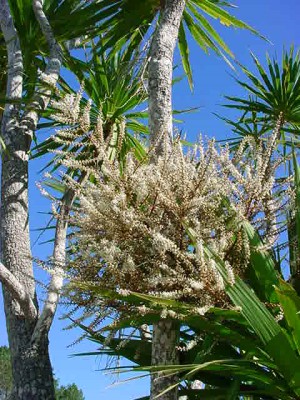 | Botanical name: Cordyline australis Common name: Cabbage Tree Cultivars: “Albertii” is a variegated form and “Purpurea” has bronze to purple leaves. Origin and habitat: New Zealand. Plant category: Tree like perennial. Height and spread: 6m high by 2 to 3 m wide. Habit and form: Open branched shrub with panicles of sword like leaves at the end of the branches. Culture and maintenance: Well drained soil in sun to part shade. Water usage: Requires little water when established. Propagation: Seed, division or stem cuttings. Environmental tolerances: Tolerates coastal exposure. Horticultural usage: Useful architectural plant. |
| Botanical name: Dianella longifolia Common name: Pale Flax Lilly Origin and habitat: Widespread across Australia. Plant category: Evergreen perennial. Height and spread: 1m x 1m. Habit and form: Tufted plant with flax like leaves. Culture and maintenance: Hardy in most conditions. Water usage: Tolerant of wet and dry conditions. Propagation: From seed or by division. Environmental tolerances: This plant is tolerant of a wide range of conditions. Horticultural usage: Useful strap-like plant that is extremely tough. The blue flowers are followed by attractive, globular fruit. | |
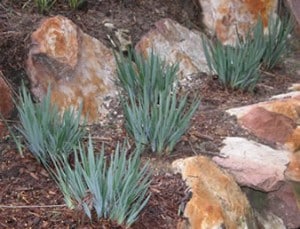 | Botanical name: Dianella revoluta “Little Rev” Common name: Flax Lilly Cultivars: This is a cultivar of D. revolute. Origin and habitat: Widespread across Australia. Plant category: Evergreen perennial. Height and spread: 0.5 x 0.5m. Habit and form: Tufted plant with flax like leaves. It has attractive grey leaves. Culture and maintenance: Hardy in most conditions. Water usage: Tolerant of wet and dry conditions. Propagation: By division. Environmental tolerances: This plant is tolerant of a wide range of conditions. Horticultural usage: Useful strap-like plant that is extremely tough. The blue/grey leaves are very eye catching. The flowers are followed by attractive, globular fruit. |
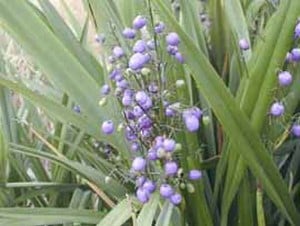 | Botanical name: Dianella tasmanica Common name: Flax Lilly Origin and habitat: Widespread across Australia. Plant category: Evergreen perennial. Height and spread: 1.2m x 1.2m. Habit and form: Tufted plant with flax like leaves. It has wider leaves than D. revolute. Culture and maintenance: Hardy in most conditions. Water usage: Tolerant of wet and dry conditions. Propagation: From seed or by division. Environmental tolerances: This plant is tolerant of a wide range of conditions. Horticultural usage: Useful strap-like plant that is extremely tough. The blue flowers are followed by attractive, globular fruit. |
| Botanical name: Verbascum olympicum Common name: Mullein. Origin and habitat: Greece. Plant category: Perennial. Height and spread: Flowers are 2m in height whilst the leaves are about 30cm high and 60cm in spread. Habit and form: Rosette forming plant with grey, hairy leaves up to 60cm long. In the second or third year they bear panicles to 1.5m tall covered with golden yellow flowers. Culture and maintenance: Plant in a well drained light soil in full sun. The plant usually dies after flowering. Pests and diseases: Powdery mildew. Water usage: Low. Propagation: From seed. Environmental tolerances: Fast growing, tolerates lime. Horticultural usage: Very striking in the herbaceous border of in mixed planting. | |


